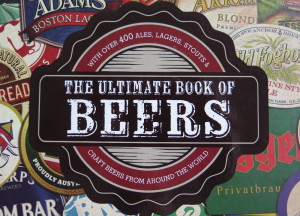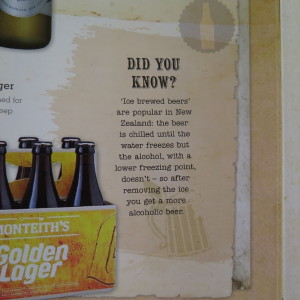Most beer writing is crap.1 This should be unsurprising and uncontroversial for the simple reason that most of everything is crap. Enshrined as Sturgeon’s law, this isn’t a cynical or depressing conclusion; just a sound observation and call for better mental hygiene. But that strangely-comforting general cause shouldn’t blind us to the idiosyncratic causes of crapness in beer commentary — insidious things which we should strive to keep in mind. Reading with your faculties more-sharply engaged is just as life-enhancing as drinking more thoughtfully is. I recommend both.

I was forcefully reminded of all this when I picked up2 The Ultimate Book of Beers, a glossy British publication3 from just last year which attempts to round-up the world and history of beer by way of two hundred pages and four hundred examples. The result is, quite frankly, terrible. But it is at least instructively terrible, and that makes it great — even though it’s not the greatness they were seeking.
Too much beer writing sinks to the level of crap insidiously, because it either is or just appears like it might be advertising in drag; most amateur and professional commentators still won’t spell out commercial entanglements with their subjects (which might account for surprisingly-strong praise or mysteriously-missing criticism, or both), or even just note that the proximate cause for them talking about some particular thing at all is that free samples from the brewery arrived in the post.4 But sometimes, you don’t even need to start pondering potential moral wrongness; occasionally something will just overdose on old-fashioned factual wrongness. Here, there were some telltale false steps early on — like retelling a debunked version of the history of IPA that’d make Martyn Cornell spin in his grave, if he wasn’t still alive — but the wheels most-obviously fell off, for me, when I flipped ahead to the New Zealand section, curious to see their summation of the place where I live, and (after all) usually drink.

The three-spread section features sixteen beers5 and manages to make errors both trifling and troubling which vary from obvious marketing-guff passed on as gospel to patently bizarre weirdness pulled from nowhere obvious. They get their hop varieties confused, slightly mangle a few brewery and beer names, entirely elide the reality and centrality of contract brewing in our modern scene (Epic, Bach, and Yeastie Boys are all listed as if they were bricks-and-mortar operations),6 completely ignore the many-branded natures of our bigger companies,7 and a give over a half-page section to a beer (namely Pink Elephant’s ‘Imperious Rushin Stowt’) that hadn’t been brewed for several years when the book was published.
The selection, as a group, is also pants-on-head nonsensical. This isn’t even destined to be useful to future generations as a (flawed) historical document because the sampling is so un-self-consciously bizarre: it doesn’t track with present or historical popularity, or award-winningness, or uniqueness, or any kind of story about what we’re doing here. It’s not even a case of “we went there and this is what we had”, which would at least be obviously personal and idiosyncratic. My best guess is that the breweries listed were the quickest to respond to requests for photos and blurbs — not a great way to go about an “ultimate” survey.

Then there’s the utterly baffling claim in a break-out text box that “ice brewed beers are popular in New Zealand”. This is an unbelievably niche practice of freezing some of the water out of beer to make what remains stronger, and you’d struggle to find more than one example around here, if that.8 When the answer to one Did you know? aside is “no, I fucking did not, because I understand what ‘knowledge’ is and your statement was complete bollocks”, all the others are cast into question. There’s basically one of these putative factoids per page, and while I’m a determined collector of trivia I’m nowhere near expert enough to rule on most of the others. The presence of that, though, is an unpromising sign. Which is a perfect microcosm for the rest of the damn book — given the smattering of errors and distortions I can spot in the accounts of beers I know, how can I put any stock in the listings for things I’d never heard of? Easy: I can’t. If they so weirdly and subtly and pointlessly flub the story of beer in New Zealand — a country so historically and culturally linked to theirs that their flag is (for now) on ours — there’s scant hope for the rest of the planet.
All of this is emblematic of wider problems: this area — like all fields of criticism and reportage — is beset by challenges of overturning myth, unpacking spin, overcoming biases, and navigating conflicts of interest. I don’t know nearly enough about the creation of this book to accuse it of falling foul on the ethics — that’s a minefield for another time and another example — but the point is that you need to be wary of crapness in all its forms and whatever its cause. And when you hear the clang of a factual error or catch the whiff of an un-declared conflict of interest, hold on to that skepticism. We should do more to make it unnecessary — and it wouldn’t take much; a little more humility, a little more honesty — but unfortunately, it’ll still serve you well.
- I am very well aware of the implications of this — including how I’m caught in its universal application. I’m taking my ‘reboot’ and ‘rededication’ quite seriously and going back to first principles on a few things, so a meta-level pondering of fundamentals seems a good thing to do early on.
- Second hand, and quite cheaply, which should possibly be — but isn’t always — a warning sign. My collections of beer books and online things-to-read both quite intentionally include the terrible as much as the terrific.
- By Mark Kelly and Stuart Derrick, two writers I’d not previously heard of — a fact which doesn’t mean a damn on a planet with seven billion people. The former is a blogger and the latter a general-purpose journalist; they certainly weren’t randoms picked off the street and hurled into a writing project.
- You know who you are. Sort that shit out.
- For the completionists: 8 Wired ‘Saison Sauvin’, Emerson’s Pilsner, Epic ‘Mayhem’, Bach Brewing ‘Hopsmacker’, Liberty ‘C!tra’, Lion Red, Stoke Smoky Ale, Mike’s IPA, Moa ‘Blanc’, Monteith’s Golden Lager, Pink Elephant ‘Imperious Rushin Stowt’, Renaissance ‘Elemental’, Speight’s ‘Old Dark’, Steinlager ‘Classic’, Tuatara APA, and Yeastie Boys ‘Digital’.
- Not that there’s anything inherently wrong with not being such, of course.
- Lion Red is described as being “produced by brewing giant Lion”, which is obvious and true enough — but you’d finish the book without learning that the Emerson’s, Speight’s, and Steinlager also listed are birthed from said same giant, if you didn’t already know.
- In a marvellous coincidence, one such beer did make an appearance at Beervana last week. And call me cynical, but I’d hardly be surprised if Lion aren’t entirely truthful that “Lion Ice” is really brewed in the old ‘eisbock’ method, anyhow.

When I was at university, I liked Flame as much as the next guy (probably more… I didn’t like beer and it was tasteless!), but that doesn’t an Ice Brewing industry make!